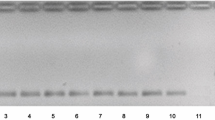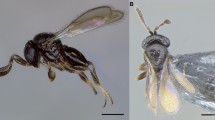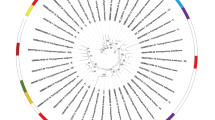Abstract
Trichogramma egg parasitoids (Hymenoptera: Trichogrammatidae) have been identified as the most important natural enemies of the golden twin-spot moth, Chrysodeixis chalcites (Esper, 1789) (Lepidoptera: Noctuidae), in banana crops grown in the Canary Islands. However, accurate identification of the Trichogramma spp. involved is complicated by their small size (<1 mm) and a general paucity of diagnostic morphological characters. Molecular identification, based on differences in DNA sequences, is commonly employed to identify Trichogramma spp., but it results in high costs associated with sequencing, and therefore may not be practical for studies aimed at surveying the distribution of species. Here, we present a simple, quick and accurate method to identify the five species of Trichogramma commonly associated with C. chalcites in the Canary Islands: T. achaeae Nagaraja and Nagarkatti, T. bourarachae Pintureau and Babault, T. euproctidis (Girault), T. evanescens Westwood and T. sp. nr. brassicae. This method is based on amplification of ribosomal DNA, using the polymerase chain reaction (PCR) with multiplexed, species-specific primers.


Similar content being viewed by others
References
Almeida RP, Stouthamer R (2003) Molecular identification of Trichogramma cacoeciae Marchal (Hymenoptera: Trichogrammatidae): a new record for Peru. Neotrop Entomol 32(2):269–272
Cabello T (1986) Especies de Trichogramma (Hym.: Trichogrammatidae) parásitas de Heliothis armigera Hub. (Lep.: Noctuidae) en Andalucía. Bol San Veg Plagas 12:323–333
Cabello T (1989) Natural enemies of noctuid pests (Lep.: Noctuidae) on alfalfa, corn, cotton and soybean crops in southern Spain. J Appl Entomol 108:80–88
Cabello T (2009) Control biológico de Noctuidos y otros Lepidópteros, pp. 279–306. In: Jacas J, Urbaneja A (eds) Control biológico de Plagas. Phytoma, Valencia, Spain, p 496
Cabello T, Gallego JR, Vila E, Soler A, del Pino M, Carnero A, Hernández-Suarez E, Polaszek A (2009) Biological control of the South American tomato pinworm Tuta absoluta (Lep. Gelechiidae), with releases of Trichogramma achaeae (Hym.: Trichogrammatidae) in tomato greenhouses of Spain. Integrated control in protected crops, Mediterranean Climate. IOBC wprs Bull 49:225–230
Cabello T, Gallego JR, Fernández FJ, Gámez M, Vila E, del Pino M, Hernández-Suárez E (2012) Biological control strategies for the south american tomato moth Tuta absoluta (Lepidoptera: Gelechiidae) in greenhouse tomatoes. J Econ Entomol 105(6):2085–2096
Ciociola AI Jr, Zucchi RA, Stouthamer R (2001) Molecular key to seven Brazilian species of Trichogramma using sequences of the ITS2 region and restriction analysis. Neotrop Entomol 30:259–262
Dang XL, Wen SY, He XF, Pang XF (2005) M-PCR: a powerful method for rapid molecular identification of Trichogramma wasps. Insect Sci 12:77–85
Davies AP, Lange CL, O’Neill SL (2006) A rapid single-step multiplex method for discriminating between Trichogramma species in Australia. J Econ Entomol 99:2142–2145
del Pino M, Carnero A, Cabello T, Hernández E (2009) Complejo de parasitoides de Chrysodeixis chalcites (Esper, 1789) (Lep.: Noctuidae) en cultivos de platanera de Canarias. VI Congreso Nacional de Entomología Aplicada. Palma de Mallorca, Spain, p 19
del Pino M, Carnero A, Cabello T, Hernández E (2011a) La lagarta o bicho camello, Chrysodeixis chalcites (Esper, 1789), una plaga emergente en los cultivos de platanera de Canarias. Phytoma 225:21–24
del Pino M, Vila E, Carnero A, Cabello T, Hernández-Suárez E (2011b) Sueltas experimentales de Trichogramma achaeae Nagaraja & Nagarkatti, 1970 (Hymenoptera: Trichogrammatidae) para el control biológico de la lagarta de la platanera, Chrysodeixis chalcites (Esper) (Lepidoptera: Noctuidae) en Canarias. VII Congreso Nacional de Entomología Aplicada. Baeza, Spain, p 102
Desneux N, Wajnberg E, Kris A, Wyckhuys G, Burgio G, Arpaia S, Narváez-Vasquez CA, González-Cabrera J, Catalán-Ruescas D, Tabone E, Frandon J, Pizzol J, Poncet C, Cabello T, Urbaneja A (2010) Biological invasion of European tomato crops by Tuta absoluta: ecology, geographic expansion and prospects for biological control. J Pest Sci 83:197–215
Fatouros NE, Huigens ME (2011) Phoresy in the field: natural occurrence of Trichogramma egg parasitoids on butterflies and moths. BioControl 57:493–502
Fauna Europaea (2010) Fauna Europaea version 2.4. Web Service available online at http://www.faunaeur.org. Accessed Sept 2012
Galán Saúco V, Cabrera Cabrera J (2006) El cultivo del plátano (Banano, Musa acuminata Colla AAA, subgrupo Cavendish) en las Islas Canarias. Memorias de la XVII Reunión Internacional de ACORBAT, Joinville, pp 289–301
Garcia P, Oliveira L, Tavares J (1998) Natural parasitism of Chrysodeixis chalcites and Autographa gamma (Lep.: Noctuidae) eggs on tomato fields. Bol Mus Mun Funchal 5:177–181
Garcia P, Oliveira L, Vieira V, Tavares J (1999) Parasióides entomófagos da ilha da Madeira: distribuiçao e hospeeiros. Boletin da SPEN 6:433–440
Gariepy TD, Kuhlmann U, Haye T, Gillott C, Erlandson M (2005) A simple-step multiplex PCR assay for the detection of European Peristenus spp., parasitoids of Lygus spp. Biocontrol Sci Technol 15:481–495
Gariepy TD, Kuhlmann U, Gillott C, Erlandson M (2007) Parasitoids, predators and PCR: the use of diagnostic molecular markers in biological control of arthropods. J Appl Entomol 131:225–240
Gibbs M, Broad GR, Polaszek A (2004) Trichogramma gicai Pintureau & Stefanescu, 2000 (Hymenoptera: Trichogrammatidae) reared as an egg parasitoid of the Madeiran endemic butterfly, Pararge xiphia (Lepidoptera: Satyridae). Bocagiana 214:1–5
Gonçalves CI, Huigens ME, Verbaarschot P, Duarte S, Mexia A, Tavares J (2006) Natural occurrence of Wolbachia infected and uninfected Trichogramma species in tomato fields in Portugal. Biol Control 37:375–381
Hegazi EM, Herz A, Hassan S, Agamy E, Khafagi W, Shweil S, Zaitoun A, Mostafa S, Hafez M, El-Shazly A, El-Said S, Abo-Abdala L, Khamis N, El-Kemny S (2005) Naturally occurring Trichogramma species in olive farms in Egypt. Insect Sci 12:185–192
Herz A, Hassan SA, Hegazi E, Khafagi WE, Nasr FN, Youssef AI, Agamy E, Blibech I, Ksentini I, Ksantini M, Jardak T, Bento A, Pereira JA, Torres L, Souliotis C, Moschos T, Milonas P (2007) Egg parasitoids of the genus Trichogramma in olive groves of the Mediterranean region. Biol Control 40:48–56
Huigens ME, Pashalidou FG, Qian MH, Bukovinszky T, Smid HM, van Loon JJA, Dicke M, Fatouros NE (2009) Hitchhiking parasitic wasp learns to exploit butterfly antiaphrodisiac. Proc Natl Acad Sci USA 106:820–825
Kumar GA, Jalali SK, Venkatesan T, Stouthamer R, Niranjana P, Lalitha Y (2009) Internal transcribed spacer-2 restriction fragment length polymorphism (ITS-2-RFLP) tool to differentiate some exotic and indigenous trichogrammatid egg parasitoids in India. Biol Control 49:207–213
Mills N (2010) Egg parasitoids in biological control and integrated pest management, Chapter 15, pp. 389–412. In: Consoli FL, Parra JRP, Zucchi RA (eds) Egg parasitoids in agroecosystems with emphasis on Trichogramma. Progress in Biological Control, vol 9. Springer, Dordrecht, The Netherlands
Nagarkatti S, Nagaraja H (1971) Redescription of some known species of Trichogramma showing the importance of male genitalia as a diagnostic character. Bull Entomol Res 61:13–31
Nagarkatti S, Nagaraja H (1977) Biosystematics of Trichogramma and Trichogrammatoidea species. Ann Rev Entomol 22:157–176
Noyes JS (2001) Universal Chalcidoidea Database. World Wide Web electronic publication. http://www.nhm.ac.uk/chalcidoids. Accessed Sept 2012
Oatman ER, Platner GR, Gonzalez D (1970) Reproductive differentiation of Trichogramma pretiosum, T. semifumatum, and T. evanescens, with notes on the geographical distribution of T. pretiosum in the southwestern United States and in Mexico (Hym.: Trichogrammatidae). Ann Entomol Soc Am 63(3):633–635
Oliveira L, Vieira V, Garcia P, Tavares J (1999) Parasitóides oófagos do género Trichogramma (Hymenoptera: Trichogrammatidae) da Ilha da Madeira. Boletim da Sociedade Portuguesa de Entomologia 6:441–446
Pinto JD (1998) Systematics of the North American species of Trichogramma (Hymenoptera: Trichogrammatidae). Mem Entomol Soc Wash 22:1–287
Pinto JD, Stouthamer R (1994) Systematics of the Trichogrammatidae with emphasis on Trichogramma, pp 1–36. In: Wajnberg E, Hassan SA (eds) Biological control with egg parasitoids. CAB International, IOBC, Wallingford, UK, p 304
Pinto JD, Platner GR, Oatman ER (1978) Clarification of the identity of several common species of North American Trichogramma (Hymenoptera: Trichogrammatidae). Ann Entomol Soc Am 71:169–180
Pinto JD, Oatman ED, Platner GR (1986) Trichogramma pretiosum and a new cryptic species occurring sympatrically in south-western North America. Ann Entomol Soc Am 79:1019–1028
Pinto JD, Velten RK, Platner GR, Oatman ER (1989) Phenotypic plasticity and taxonomic character in Trichogramma (Hymenoptera: Trichogrammatidae). Ann Entomol Soc Am 82:414–425
Pinto JD, Stouthamer R, Platner GR, Oatman ER (1991) Variation in reproductive compatibility in Trichogramma and its taxonomic significance (Hymenoptera: Trichogrammatidae). Ann Entomol Soc Am 84:37–46
Pintureau B (2008) Les espèces européennes des trichogrammes. Libro Veritas, Cergy-Pontoise, France, p 95
Pintureau B, Babault M (1988) Systématique des espèces africaines des genres Trichogramma Westwood et Trichogrammatoidea Girault (Hym. Trichogrammmatidae). Les Colloques de l’INRA 43:97–120
Pintureau B, Voegelé J (1980) Une nouvelle espèce proche de Trichogramma evansescens: T. maidis (Hym. Trichogrammatidae). Entomophaga 25:431–440
Pintureau B, Oliveira L, Anunciada L (1991) Contribution to the study of the egg parasitic Hymenoptera of the Azores Islands, pp. 115–118. In: Wajnberg E, Vinson SB (eds.). Trichogramma and Other Egg Parasitoids, 3rd International Symposium, Les Colloques de l’INRA, Paris, France, vol 56
Pizzol J, Voegelé J, Marconi A (1997) Efficacité de Trichogramma evanescens contre Chrysodeixis chalcites (Lep., Noctuidae) en culture de tomate sous serre. ANPP—4º Conf. Int. sur les Ravageurs en Agriculture, Montpellier, France, 6–8 janvier:751–757
Polaszek A (2010) Biodiversity and host associations of Trichogramma in Eurasia, Chapter 9, pp. 237–266. In: Consoli FL, Parra JRP, Zucchi RA (eds) Egg parasitoids in agroecosystems with emphasis on Trichogramma. Progress in Biological Control, vol 9. Springer, Dordrecht, The Netherlands
Polaszek A, Rugman-Jones P, Stouthamer R, Hernández-Suarez E, Cabello T, del Pino-Pérez M (2012) Molecular and morphological diagnoses of five species of Trichogramma: biological control agents of Chrysodeixis chalcites (Lepidoptera: Noctuidae) and Tuta absoluta (Lepidoptera: Gelechiidae) in the Canary Islands. BioControl 57:21–35
Rasplus JY, Villemant C, Paiva MR, Delvare G, Roques A (2010) Hymenoptera. BioRisk 4(2):669–776
Roy HE, Roy DB, Roques A (2011) Inventory of terrestrial alien arthropod predators and parasites established in Europe. BioControl 56:477–504
Rozen S, Skaletsky HJ (2000) Primer3 on the WWW for general users and for biologist programmers, pp 365–386. In: Krawetz S, Misener S (eds) Bioinformatics methods and protocols: methods in molecular biology. Humana Press, Totowa, USA
Rugman-Jones P, Morse JG, Stouthamer R (2009) Rapid molecular identification of armored scale insects (Hemiptera: Diaspididae) on Mexican “Hass” Avocado. J Econ Entomol 102(5):1948–1953
Rugman-Jones P, Forster LD, Guerrieri E, Luck RF, Morse JG, Monti MM, Stouthamer R (2011) Taxon-specific multiplex-PCR for quick, easy, and accurate identification of encyrtid and aphelinid parasitoid species attacking soft scale insects in California citrus groves. BioControl 56:265–275
Russo J, Pintureau B (1981) Etude biométrique de quatre espèces de Trichogramma Westwood (Hym. Trichogrammatidae). Annales de la Société Entomologique de France 17:241–258
Silva IMMS, Honda J, van Kan FJPM, Hu J, Neto L, Pintureau B, Stouthamer R (1999) Molecular differentiation of five Trichogramma species occurring in Portugal. Biol Control 16:177–184
Smith SM (1996) Biological control with Trichogramma: advances, successes, and potential of their use. Annu Rev Entomol 41:375–406
Stouthamer R, Hu J, van Kan FJPM, Platner GR, Pinto JD (1999) The utility of internal transcribed spacer 2 DNA sequences of the nuclear ribosomal gene for distinguishing sibling species of Trichogramma. BioControl 43:421–440
Stouthamer R, Jochemsen P, Platner GR, Pinto JD (2000) Crossing incompatibility between Trichogramma minutum and T. platneri (Hymenoptera: Trichogrammatidae): implications for application in biological control. Environ Entomol 29:832–837
Sumer F, Tuncbilek AS, Oztemiz S, Pintureau B, Rugman-Jones P, Stouthamer R (2009) A molecular key to the common species of Trichogramma of the Mediterranean region. BioControl 5:617–624
van der Linden A (1996) Control of caterpillars in integrated pest management. Integrated control in glasshouses. IOBC/WPRS Bull 19(1):91–94
van Harten A, Monteiro Neves A, Mendes Brito J (1990) Importação, criação, libertação e recuperação de parasitas e predadores de pragas em Cabo Verde no periodo Abril 1983–Dezembro 1987. Investigação Agrária 3(2):39–49
Vila E, Parra A, Gallego JR, Fernández FJ, Cabello T (2010) Biological control of the South American tomato pinworm, Tuta absoluta (Lep.: Gelechiidae), with releases of Trichogramma achaeae (Hym.: Trichogrammatidae) on different tomato crop cycles in Spain. IXth Eur Cong Entom 22–27 August. Budapest, Hungary, p 121
Voegelé J, Pintureau B (1982) Caractérisation morphologique des groupes et espèces du genre Trichogramma Westwood. Les Colloques de l’INRA 9:45–75
White TJ, Bruns T, Lee S, Taylor JW (1990) Amplification and direct sequencing of fungal ribosomal RNA genes for phylogenetics, pp. 315–322. In: Innis MA, Gelfand DH, Sninsky JJ, White TJ (eds) PCR protocols: a guide to methods and applications. Academic Press, New York, USA
Wright MG, Stouthamer R (2011) First report of Trichogramma achaeae (Hymenoptera: Trichogrammatidae) from Hawaii. Proc Hawaii Entomological Soc 43:67
Yaseen M, Klas FE (1979) Introduction of exotic parasites for control of Spodoptera and Heliothis in Trinidad. Proc Caribb Food Crops Soc 15:136–141
Acknowledgments
We are grateful to AgroBío S. L. and ASPROCAN for their financial support and collaboration during Trichogramma field collection. The senior author’s research (MPP) was supported financially by a pre-doctoral fellowship granted by “Instituto Nacional de Investigación y Tecnología Agraria y Alimentaria (INIA)”. The paper benefited greatly from comments by two anonymous reviewers.
Author information
Authors and Affiliations
Corresponding author
Additional information
Handling Editor: Torsten Meiners
Rights and permissions
About this article
Cite this article
del Pino, M., Rugman-Jones, P., Hernández-Suárez, E. et al. Rapid molecular identification of five species of Trichogramma occurring in the Canary Islands with notes on their distribution in banana groves. BioControl 58, 515–524 (2013). https://doi.org/10.1007/s10526-013-9519-x
Received:
Accepted:
Published:
Issue Date:
DOI: https://doi.org/10.1007/s10526-013-9519-x




